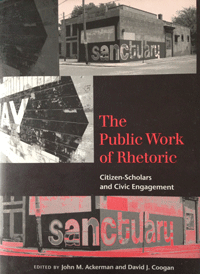The Public Work of Rhetoric
Citizen-Scholars and Civic Engagement
Edited by John M. Ackerman and David J. Coogan
Reviewed by Jennifer Clifton, University of Texas at El Paso

Figure 1. Book cover of
The Public Work of Rhetoric
(Ackerman & Coogan, 2010).
The current state of public life in the United States makes clear the need not only to delve more deeply into the public work of rhetoric but also to critically examine how public rhetoric intersects with the roles we occupy as researchers, rhetoricians, educators, and community partners. John Ackerman and David Coogan's (2010) edited collection, The Public Work of Rhetoric: Citizen-Scholars and Civic Engagement, has offered an exploration of disciplinary conundrums, everyday frustrations, discursive impasses, educational possibilities, and transformative moments related to civic engagement and social change among people within and outside of academic institutions.
Ackerman and Coogan opened this edited collection by charting communication and composition studies' conflicted disciplinary history with phronesis—
practical wisdom gained from experience and judgment of the particular. Drawing attention to such disciplinary conflicts and ill-ease, Ackerman and Coogan
marked a kairotic moment wherein scholars might reclaim the capacity of rhetoric to do significant, meaningful work in public life
(p. 4).
As the editors noted, phronesis has had a tenuous home in the academy, partially, because its applied
nature requires theories that are responsive to and tested by ongoing action in a constrained world, and partially because of its connection to
intervention, where colonizing doer-done to relations have sometimes wreaked havoc on community partners. Importantly, they noted that this is
no easy task given disciplinary perceptions of public work which have framed the public as landing pad
for rhetorical work in classrooms or publics as unruly not… contained by (or easily
explained by) the rhetorical tradition, either in substance, style, or
medium
(p. 4)—or public perceptions of rhetoric as powerful and deceptive, yet useless.
Calling for a disciplinary renewal of public rhetorics, Ackerman and Coogan have not only rejected the idea that rhetoric
has somehow denied itself or has turned in on itself as a meta-discipline that has crossed boundaries of disciplines and contexts, but
also dismissed the notion that the polis is dead or missing. They argued that researchers, teachers, and community members
must set aside their hesitation with public rhetorics by returning “to the street and an awareness of the conspiracies against democracy
that loom there” (p. 10)—conspiracies that have become even more insidious under globalization. In an era where the boundaries
and identities of resident and citizen transcend national borders and where globalized capitalism would either conflate or usurp
public life with entrepreneurialism,
Ackerman and Coogan asked, what is rhetoric’s role in reconfiguring the polis and in
reconstituting the work of the polis?
(p. 10). Without shying away from the discomforts and uncertainties of actually existing
democracy (Fraser, 1989), chapters have taken up this question by examining the political and ethical dimensions of real events
and real social relations
(Ackerman & Coogan, p. 8).
Scholars and educators in communication, composition, rhetoric, public policy, and community literacy will find that this collection
has considered some of the most vexing and important questions of street phronesis.
The collection has certainly accomplished the
difficult work of making rhetorical theorizing do-able, teachable and, above all, increasingly useful in the complicated transactions where people's
private lives and public institutions intersect (p. 10). Courageously, the collection has determined to make visible the knotty
underside of the warp and woof of contemporary public life by confronting the thorniest of disciplinary questions. That is, the collection has created
a middling, reflexive space that is proudly agonistic, deliberative, reciprocal, and in-between—mirroring the true grit and tumble of public life
(p. 12). Newcomers and veterans in these fields, as well as any scholar considering possibilities and theoretical frames for engagement
in higher
education, will find this collection compelling, insightful, and worthwhile, if also somehow discomforting. The discomfort, however, is in itself
representative of the noise of public life. While some chapters have considered more hopeful possibilities for public life, others offered scathing
critiques—showing that the rhetoric of public life is often neither pragmatic nor inclusive nor necessarily hopeful. And yet,
Ackerman and Coogan have reject[ed] the idea that public life is dead, that it has been stripped of agitation, assembly, and deliberation
(p. 8).
Indeed, the collection itself, with its focused and dissenting views, has shown the productive (and hopeful) value of agitation, assembly, and
deliberation.
Readers will find chapters that focused on:
commonplacesas organizers for making arguments and producing discourse (Rai; Cintron)
free speech(Jarratt)
Overall, the collection has both created and called for a postmodern paidiea
(p. 8), a rough ground of inclusive democracy where traction is
gained precisely because of friction, not in spite of it (Wittgenstein, 1953, p. 107). After all, as Ackerman and Coogan (2010) reminded readers, We are
not all building the same things for the same reasons with the same tools in the same public
(p. 8).
While I have spent time reviewing each of the chapters, I have extensively commented on and wrestled with a few with the aims of 1) puzzling through questions important to my own work, 2) highlighting some of the most pressing disciplinary questions that emerged in the collection, and 3) participating in the healthy (Bruner) and generative (Juergensmeyer & Miller) public work of dissensus. In this review, I have grouped together chapters that seem to be in focused conversation. Where accessible and applicable, I have included links to resources that are central to the arguments being made. My hope is that this organization helps readers to contextualize the content of these chapters within disciplinary questions and within the public arenas where the authors have situated their work.